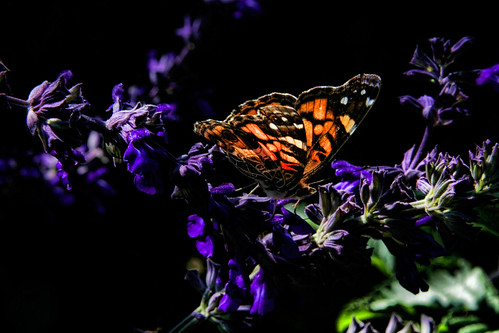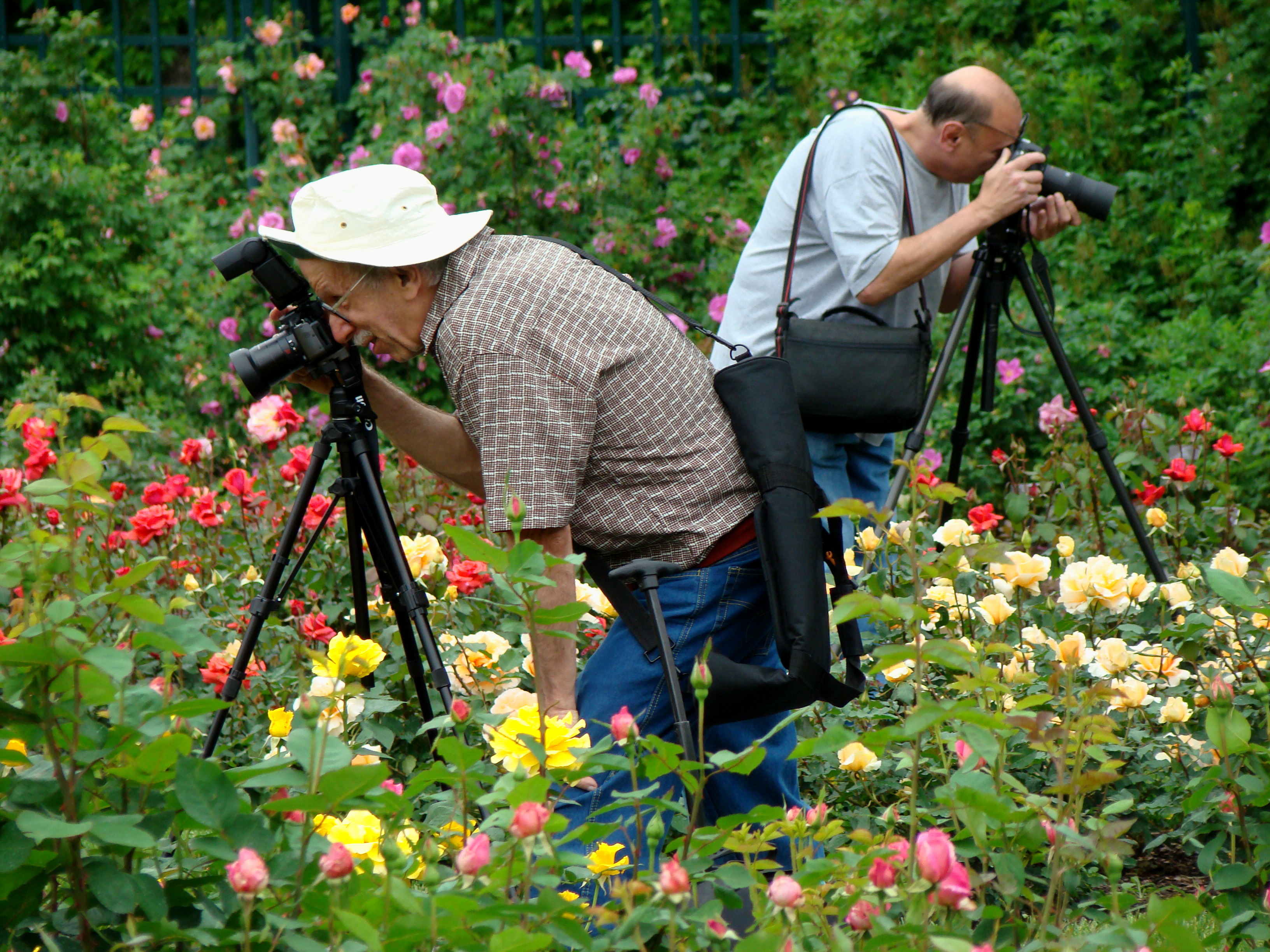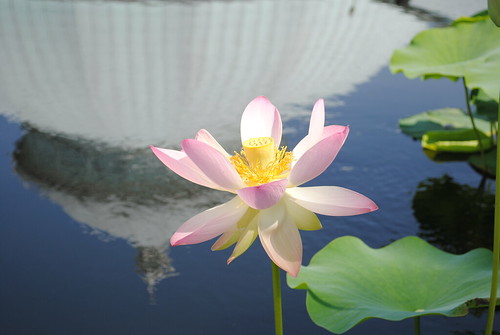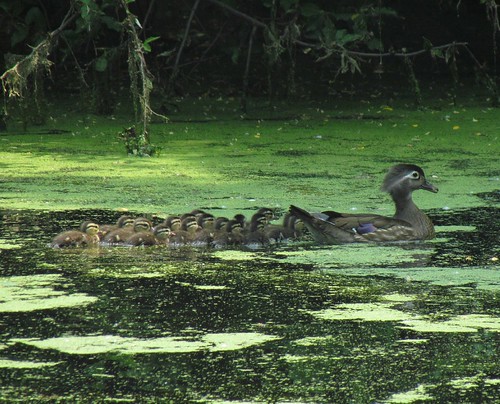Looking Back: March 2011
Posted in Photography on December 24 2011, by Ann Rafalko
In March 2011 we introduced you to the stars of The Orchid Show: On Broadway.

Inside The New York Botanical Garden
Posted in Photography on December 24 2011, by Ann Rafalko
In March 2011 we introduced you to the stars of The Orchid Show: On Broadway.
Posted in Behind the Scenes, Science on September 15 2011, by Sandy Wolkenberg
Ed. note: Sandy Wolkenberg is a Citizen Scientist who has been working in the Thain Family Forest for three and a half years. Over the course of a week on Plant Talk, Sandy will share a five-part series of posts on The New York Botanical Garden’s Citizen Scientist Tree Phenology Program. If Sandy’s experiences motivate you to want to know more about becoming a Citizen Scientist, check out the Garden’s Volunteer Program page.
In the fall of 2008, at the beginning of the Citizen Science Tree Phenology program, the Volunteer Office encouraged those of us participating to find partners to work with. Because of my variable schedule at the Garden, I ended up walking the Spicebush Trail in the Thain Family Forest by myself. These walks often occurred in the early morning when intense sun glare or mist made identification of phenological phases difficult. In retrospect, although I treasured those quiet phenology walks, I had so little history with the program and so very many questions about what I was seeing, or hoped I was seeing, or imagined that I was seeing, that the prospect of walking with other volunteers was compelling. So it was a fortunate time when, in the spring of 2008, phenologists received the following email from Volunteer Services:
Posted in Behind the Scenes, Science on September 14 2011, by Sandy Wolkenberg
Ed. note: Sandy Wolkenberg is a Citizen Scientist who has been working in the Thain Family Forest for three and a half years. Over the course of a week on Plant Talk, Sandy will share a five-part series of posts on The New York Botanical Garden’s Citizen Scientist Tree Phenology Program. If Sandy’s experiences motivate you to want to know more about becoming a Citizen Scientist, check out the Garden’s Volunteer Program page.
Now, imagine that it is early to mid-March, the beginning of the spring season. Citizen Scientists excitedly descend upon the Thain Family Forest! We scan the designated trees looking for “emerging leaves.” Protocols describe ”emerging leaves” as follows: ”In at least 3 locations on the plant, an emerging leaf is visible. A leaf is considered emerging once the green tip is visible at the end of the leaf bud, but before it has fully unfolded to expose the leaf stalk (petiole) or leaf base.”
Aching necks and high fives! Learn more about the joys of phenology below.
Posted in Around the Garden on August 10 2011, by Rustin Dwyer

It’s the second month of our photo contest, and a hearty congratulations to Barbara Reiner for winning our second monthly NYBG-IGPOTY photography contest. The NYBG photo judges had a tough time picking the winner this month, but in the end felt that Barbara’s rose triptych just edged out cindy {k}’s scene among the tulips for this month’s theme “American Beauty.” Barbara will receive a NYBG gift pack, which includes two All-Garden Passes, a $25 credit towards the Adult Education class of her choice, a catalog for the Library exhibition Historical Views: Tourists at the Alhambra, and the catalog from Hirschfeld’s Broadway Scrapbook. We’re also still working on getting copies of the photography book, Better Plant and Garden Photography, written by IGPOTY founder Philip Smith, over from the U.K. as well. Congratulations Barabara! Please send us an email with your contact information through this form (select website from the pull-down menu).
Head below the jump to see the rest of this month's winners.
Posted in Photography on July 12 2011, by Ann Rafalko
We asked Philip Smith, professional photographer and co-founder and Managing Director of the International Garden Photographer of the Year contest for his thoughts on our first NYBG-IGPOTY monthly photo contest winners. Here’s what Philip had to say.
Butterflies take a lot of patience and you have to get through a lot of shots before the right one appears in the viewfinder. The winning shot is a great example of the way photography is really about light and about ‘chasing the light’. To achieve the vision of light filtered through a butterfly’s wing is a testament not only to patience but also to Heather Lang’s skill.

The second placed shot by Patricia Gonzalez is actually my favourite–but then I am always attracted by humour and fun in images. This is a beautifully seen composition with the two photographers working visually in opposite directions. The foreshortening of the long lens makes them look as if they are close together, blissfully unaware of each other. This is a picture about passion and enjoyment–exactly what the category ‘Breathing Spaces’ in International Garden Photographer of the Year is all about. Patricia must have waited carefully for the exact moment when both photographers were looking through the viewfinder to create that sense of symmetry–very clever.

Can you get more photogenic than a lotus flower? The soft light falling on this bloom is exquisite. I think I might have wanted to shift position a bit to simplify the composition to exclude the foliage and maybe tell us a bit more about its context in NYBG, but there is a lot of atmosphere in this shot.

Thank you Philip! July isn’t even half over yet, plenty of time left to enter this month’s contest. The theme is “American Beauty.” Simply join the NYBG Group Pool on Flickr, and then tag your photo with nybgigpoty2. That’s it! At the end of the month we’ll convene a panel of photography experts and report back with the winners. Good luck, and keep snapping!
Posted in Photography on July 7 2011, by Ann Rafalko

A huge congratulations to Heather Lang for winning our first monthly NYBG-IGPOTY photography contest. The panel of NYBG judges felt that Heather’s photo of a butterfly (on what looks to be an ornamental sage) was the tops in capturing the June theme of “Picturing Summer.” Heather will receive a NYBG swag bag, which includes two All-Garden Passes, a $25 credit towards the Adult Education class of her choice, a catalog for the Library exhibition Historical Views: Tourists at the Alhambra, and the catalog from Hirschfeld’s Broadway Scrapbook. We’re also working on getting copies of the photography book, Better Plant and Garden Photography, written by IGPOTY founder Philip Smith, over from the U.K. as well. Congratulations Heather! Please send us an email with your contact information through this form (select website from the pull-down menu).
Coming in a close second is this photograph by Patricia Gonzalez which, humoursly (and literally) captures the theme with a pair of shutterbugs snapping away in the Peggy Rockefeller Rose Garden.

In third place is this iconic NYBG image of a lotus taken in the Conservatory courtyard pool by Elizabeth Mueller.

We had 35 photographs entered into this first contest, and the quality was really high. It was difficult settling upon a winner, so congratulations to Heather, Patricia, and Elizabeth!
For the July contest we have picked the theme “American Beauty.” Stumped? Don’t be! Be creative! Pictures needn’t be patriotic, or all red, white, and blue. Perhaps you snapped a shot of Benjamin Franklin’s choice to be our national bird–the turkey–walking around the grounds, or maybe you took a plant portrait of a rose with an all-American name. If you’re afraid we might miss the point of your photo, please include an explanation in the description area. For the July contest, please use the tag nybgigpoty2.
And let’s simplify matters a bit this month, too. Why doesn’t everyone just limit themselves to five photos. Don’t worry about entering one per week. Feel free to plop them all into the group, en masse. And as always, please let me know if you have any questions.
Congrats again to the winners!
Posted in Around the Garden on June 27 2011, by Patricia Gonzalez
| Patricia Gonzalez is an NYBG Member and avid amateur wildlife photographer. She is especially fond of taking photographs at the Garden. |
In previous posts, I encouraged my fellow wildlife photographers to visit The New York Botanical Garden, shared one of my red-tailed hawk encounters, and gave tips on how to make the most out of your visit.
Today’s topic is the one thing that I think every New York City wildlife photographer should consider investing in. With this, not only will you have access to the grounds and great attractions the Garden offers year round, but you’ll also be able to enter the Garden before the public does. What is it? It’s an Annual Supporting Membership.
As a Supporting Member, not only will you get a neat membership card for yourself and one other person (which in turn, gets you into the Conservatory, Rock Garden, Everett Children‘s Adventure Garden, and more) both of you will get what I like to call “the golden ticket:” An early-morning grounds pass which grants you access to the Garden’s stunningly beautiful 250-acres before they open to the public at 10:00 a.m. With this pass, you can arrive as early as 6:00 a.m. and shoot till your heart’s content.
Birdwatchers will tell you that some of the best activity takes place in the morning. Think about it … With this one pass you gain the opportunity to shoot red-tailed hawks, owls, muskrats, rabbits, turtles, frogs, and way too many other species of birds to list, 52-weeks a year.
An annual supporting membership is $250. Yes, that might seem a bit steep, especially in today’s economy, but you can cut the cost in half if you join with another person. I convinced my best friend who is also an amateur photographer to join with me, which brings the cost down to $125 each. Although the membership is in my name, we both got individual membership cards and early morning grounds passes.
I look at it this way; the money is going to keep a place that I love operating. Just the opportunity to photograph hawks, owls, and other wildlife with only a few folks around 52-weeks a year is enough to get me to re-up every year. My last four close-up encounters happened before 7:30 a.m.!
You just show your pass to the security guard at either entrance and you’re in. During one of my more recent adventures, I came across two young great-horned owls and one of their parents in the native forest around 6:45 a.m. I was able to get some great shots and video.
If you just want to go solo and don’t care about the pass, then join as an individual at $75. You can check out all the different levels of membership here.
If you still need convincing, then go to my photo site and see for yourself. Look into the eyes of the owls, hawks and other wildlife and imagine yourself in the Native Forest, camera in hand, the smell of damp earth in the air and the sounds of the natural world around you. It doesn’t get any better than this.
Posted in Photography, Wildlife on May 27 2011, by Ann Rafalko
NYBG Member and amateur wildlife photographer Patricia Gonzalez took these amazing photographs of a mama Wood Duck and her 17 ducklings!

Can you imagine trying to keep them all straight?

What would you name each of them?
Posted in Members, Photography, Wildlife on April 22 2011, by Patricia Gonzalez
| Patricia Gonzalez is an NYBG Member and avid amateur wildlife photographer. She is especially fond of taking photographs at the Garden. |
In part one, I encouraged shutterbugs who love shooting wildlife to visit The New York Botanical Garden and shared one of my encounters there. Today, I’ll give you some tips on how to make the most out of your visit.
Dress comfortably and efficiently
A typical outing at the Garden can last me anywhere from three to six hours, so it’s important to dress comfortably. During my adventures, I always wear cargo pants (BDUs) and boots. Cargo pants because they are loose-fitting and have lots of pockets for your gear and boots for the terrain. If you really want to better your chances of encountering wildlife, then no visit to the Garden would be complete without exploring all the Native Forest trails as well as the path that runs along the Bronx River. These paths can get pretty muddy, especially at the entrance to the individual trails, so hiking boots are strongly recommended. In winters like this past one that brought mega-blizzard after mega-blizzard, you’ll need snow boots.
Bring an extra battery
This might seem like a silly suggestion, but I’m always hearing this “I would have taken more shots, but my battery ran out, so I went home.” You’d be surprised how quickly a day can fly by. Always bring an extra camera battery and keep it someplace where you can reach for it quickly when your on-screen indicator starts flashing. I keep a fully-charged spare in the outside pocket of my camera bag.
Where to find the hawks
Everybody with a camera wants to get a shot of one of the beautiful red-tailed hawks and other raptors that hunt at the NYBG. Although Rose and Vince have their nest on the nearby Fordham University Campus, the Bronx Zoo and the Botanical Garden are all part of their hunting grounds. Younger red-tails believed to be Rose’s offspring hunt regularly at the Garden along with cooper’s hawks, sharp-shinned hawks, and the two resident great-horned owls. So, where in the Garden can these winged hunters be found? The answer is: Everywhere. Hawks pretty much go where they want and there is no specific all-year-round spot. However, I’ve had some very good luck lately in the Native Forest on the trails that border the Azalea Garden, and near the Library Building.
Have patience
Let’s say you’ve been walking around for several hours and you’re beginning to feel like you haven’t seen anything. Instead of leaving, take a break. Why not head on over to the Visitor’s Center Café? I survived my freezing winter treks on their most excellent hot chocolate. Enjoy your drink of choice while enjoying the nice view. After about a half hour there, I’m refreshed, rejuvenated and ready to continue on. Once you head out, re-trace some of the ground you covered earlier. One time, I had walked around non-stop for nearly five hours, hoping to shoot one of the red-tails there. I got nothing, but came back a half hour later and took the photo you see above. It was definitely worth heading out for a second look.
Want to photograph wildlife all year? Then join the Garden. A Garden Membership will get you and your camera unlimited entry to the grounds, the Conservatory, the exhibits in the Library Building, and to all the wonderful events that take place throughout the year.
Posted in Members, Photography, Wildlife on April 5 2011, by Patricia Gonzalez
| Patricia Gonzalez is an NYBG Member and avid amateur wildlife photographer. She is especially fond of taking photographs at the Garden. |
You do not have to leave the five boroughs of New York to see wildlife. In fact, you’re only a train, subway, or bus ride away!
For the last three years that I have been a Member, I have had the pleasure of photographing different members of the animal kingdom at The New York Botanical Garden. The garden is a wildlife photographer’s dream. Within the Garden’s 250-acres you will find a forest, wetlands, streams, and two lakes–each one home to all manner of creatures–from cardinals to wild turkeys, from rabbits to red-tailed hawks, from mallards to muskrats. One can easily go through an entire camera battery (or two) trying to shoot them all (with your camera, of course).
Here is an example of one of my recent mornings taking photos at the Garden:
Several weeks ago, I was walking down Azalea Way which is one of the garden’s main roads with camera in hand. To my left was the edge of the Native Forest and to my right the Azalea Garden. I was talking on my cellphone when I noticed the distinctive silhouette of a red-tail hawk on a tree to my right, just before Azalea Way meets with the Stone Mill Road.
I told the person on the other end that I’d have to call them back and switched my phone to vibrate so that if it rang, the sound wouldn’t scare the hawk away. I tip-toed ahead to a point where the sun was to my back and began shooting. The hawk stayed there for a bit and pretty soon I was right below him. I kept on shooting. After about five minutes, he crouched down and I knew he was going to take off. He then leaped right over me. For the second that it took him to do that he was only about four feet above my head. He glided on to the other side of the road, over the wooden fence with his talons extended, and landed on the forest floor with a light thud. I assumed that he had caught something, so I waited for the meal to begin. When a red tail captures prey, they will typically begin looking around, darting their head left and right. As the hawk was doing this with has his back to me, I slowly moved in closer all the while shooting between the fence posts.
Sometimes a young hawk will mistake an inanimate object for prey, which is what I think happened here. Eventually realizing that there was nothing there, he took a few steps and scrunched down as if to fly off again. Instead, he hopped on to the fence. I eased closer until I was about 15 feet away. That’s when I shot this. Ladies and gentlemen, look into the eyes of the natural world. He was even nice enough to let me shoot some video. As you can see, vehicles and distant sirens don’t seem to phase him either.
I shot about 50 photos while he was on that wooden fence. I’d never been this physically close to a red-tail before. I could see the color of his eyes, the detail in his feathers, his talons. I was truly in awe of this winged hunter. Further up Azalea Way I could see a group of four talking loudly. The hawk turned his head to look at them and I knew he was about to leave, so I just kept shooting. Seconds later he took off. I then ran home to look at the photos on my computer. It was there that I noticed the blood on his beak, most likely from a previous meal.
This was just one of the many events of nature that I’ve been blessed to witness during my photographic adventures at the Garden. Looking into the eyes of that magnificent raptor is something that will stay with me for the rest of my life. I encourage all photographers–amateur or pro, wildlife or scenic–not just to visit the Garden, but to become a Member. For the cost of an annual membership, you get unlimited entry to the grounds, the Conservatory, the exhibits in the Library Building, and all the other wonderful events that take place there throughout the year. Just don’t forget to bring your camera!
Next up: Pat gives us some practical tips for getting the most out of your photographic safari at the Garden. Stay tuned!